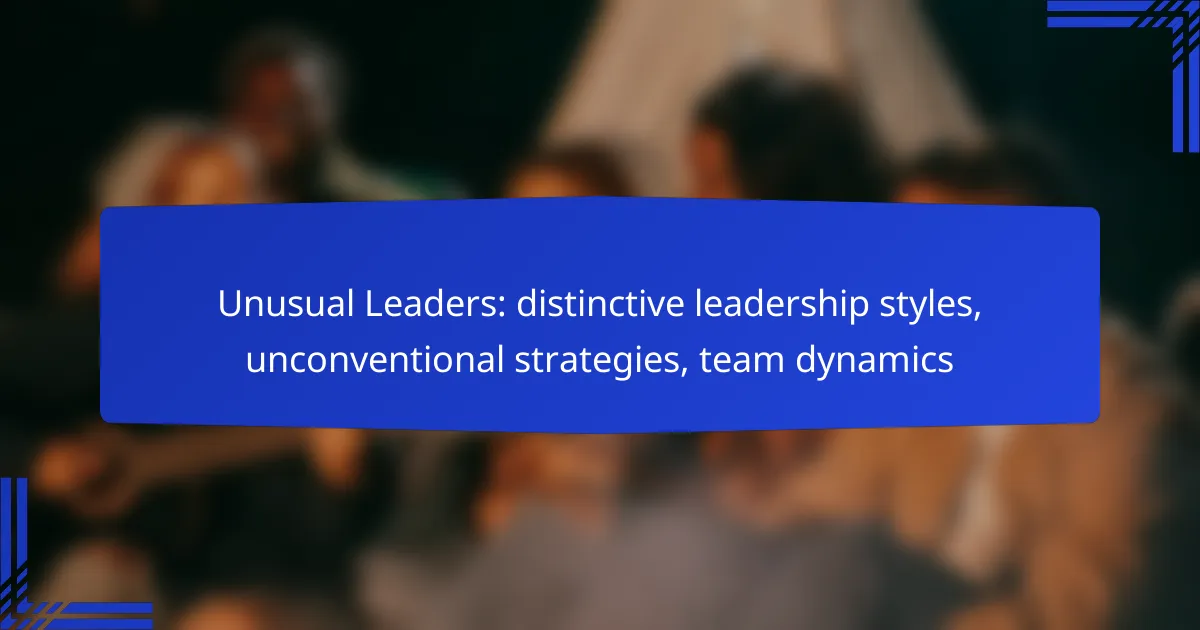Unusual leaders often distinguish themselves through distinctive leadership styles and unconventional strategies that challenge traditional norms. By fostering unique team dynamics, these leaders create environments ripe for innovation and collaboration, ultimately driving enhanced performance and creativity within their organizations.

What are the distinctive leadership styles of unusual leaders?
Unusual leaders often employ distinctive leadership styles that set them apart from traditional approaches. These styles can foster unique team dynamics and drive innovative strategies, enabling organizations to thrive in competitive environments.
Transformational leadership
Transformational leadership focuses on inspiring and motivating team members to exceed their own self-interests for the sake of the organization. Leaders in this style actively engage with their teams, fostering an environment of trust and collaboration.
Key aspects include setting a compelling vision, encouraging personal growth, and recognizing individual contributions. For example, a transformational leader might implement regular feedback sessions to help team members develop their skills and align with the organization’s goals.
Servant leadership
Servant leadership prioritizes the needs of the team and encourages leaders to serve first, putting others before themselves. This approach fosters a culture of empathy and support, leading to higher morale and job satisfaction.
Servant leaders often focus on empowering their teams by providing resources and opportunities for professional development. An effective servant leader might regularly check in with team members to understand their challenges and offer assistance, creating a strong sense of community.
Charismatic leadership
Charismatic leadership relies on the personal charm and persuasive abilities of the leader to inspire and motivate followers. These leaders often have a strong vision and communicate it passionately, which can galvanize teams around shared goals.
While charisma can be a powerful tool, it can also lead to dependency on the leader’s personality. For instance, a charismatic leader might rally a team during challenging times, but it’s essential to ensure that the team’s success is not solely tied to the leader’s presence.
Participative leadership
Participative leadership involves team members in the decision-making process, fostering a sense of ownership and commitment to outcomes. This style encourages collaboration and values diverse perspectives within the team.
Leaders practicing this approach often hold brainstorming sessions or workshops to gather input from team members. This can lead to more innovative solutions and a stronger team dynamic, as everyone feels their voice is heard and valued.
Situational leadership
Situational leadership adapts the leader’s style based on the context and the needs of the team. This flexibility allows leaders to respond effectively to varying challenges and team dynamics.
For example, a leader might take a directive approach with a new team member who requires more guidance, while adopting a more delegative style with experienced team members. Understanding when to adjust leadership styles is crucial for maintaining team effectiveness and morale.

How do unconventional strategies impact team dynamics?
Unconventional strategies can significantly enhance team dynamics by fostering a culture of innovation and collaboration. These approaches often lead to increased engagement and motivation among team members, resulting in improved performance and creativity.
Encouraging risk-taking
Encouraging risk-taking allows team members to experiment with new ideas without the fear of failure. This can lead to innovative solutions and breakthroughs that traditional approaches might overlook. Leaders should create a safe environment where calculated risks are supported and celebrated.
To implement this, consider setting up regular brainstorming sessions where team members can pitch bold ideas. Recognizing and rewarding those who take risks can further motivate the team to step outside their comfort zones.
Fostering open communication
Open communication is essential for effective teamwork, especially when unconventional strategies are employed. It ensures that all voices are heard and that team members feel valued, which can lead to more diverse perspectives and ideas.
Leaders can promote open communication by establishing regular check-ins and encouraging feedback. Tools like anonymous surveys can also help gather honest opinions, making it easier for team members to express their thoughts without fear of judgment.
Implementing flexible roles
Flexible roles within a team allow members to adapt to changing project needs and leverage their unique strengths. This adaptability can lead to a more dynamic and responsive team capable of tackling challenges creatively.
To implement flexible roles, leaders should assess team members’ skills and interests, allowing them to take on various responsibilities. This not only enhances engagement but also helps in skill development across the team.
Emphasizing collaboration
Emphasizing collaboration fosters a sense of unity and shared purpose among team members. When individuals work together towards common goals, they are more likely to support each other and contribute to a positive team culture.
Leaders can enhance collaboration by organizing team-building activities and promoting cross-functional projects. Establishing clear goals and celebrating team achievements can also strengthen collaborative efforts and build trust within the group.

What are the benefits of unconventional leadership approaches in Canada?
Unconventional leadership approaches in Canada can lead to significant advantages, including fostering innovation and enhancing team dynamics. By breaking away from traditional methods, leaders can create environments that encourage unique perspectives and active participation from team members.
Enhanced creativity
Unconventional leadership styles often prioritize creative thinking and problem-solving. Leaders who embrace flexibility and encourage experimentation can inspire their teams to generate innovative ideas without the fear of failure. For example, a leader might implement brainstorming sessions where all ideas are welcomed, regardless of how unconventional they may seem.
This creative environment can lead to the development of unique products or services that differentiate a company in the competitive Canadian market. Encouraging diverse viewpoints can also result in more comprehensive solutions to complex challenges.
Improved employee engagement
When leaders adopt unconventional strategies, they often foster a more inclusive atmosphere that boosts employee engagement. By valuing input from all team members and recognizing individual contributions, leaders can create a sense of ownership and commitment among staff. This can manifest in higher job satisfaction and lower turnover rates.
For instance, leaders might implement regular feedback loops or informal check-ins, allowing employees to voice their opinions and feel heard. Engaged employees are typically more productive and motivated, directly benefiting the organization.
Increased adaptability
Unconventional leadership approaches can enhance a team’s ability to adapt to changing circumstances. Leaders who encourage agility and open-mindedness prepare their teams to respond effectively to new challenges or market shifts. This adaptability is crucial in today’s fast-paced business environment, especially in sectors like technology and retail.
For example, a leader might promote cross-functional collaboration, enabling teams to pivot quickly when necessary. By fostering a culture of continuous learning and flexibility, organizations can better navigate uncertainties and seize emerging opportunities in the Canadian landscape.

What criteria should be considered when evaluating unusual leaders?
When evaluating unusual leaders, consider their unique approaches to leadership, the impact of their strategies on team dynamics, and the overall effectiveness of their unconventional methods. Key criteria include leadership effectiveness, team performance metrics, and employee satisfaction surveys.
Leadership effectiveness
Leadership effectiveness can be assessed by examining how well unusual leaders achieve their goals and inspire their teams. This includes evaluating their decision-making processes, communication styles, and ability to foster innovation. For instance, a leader who encourages risk-taking may drive creativity but could also face challenges in maintaining stability.
To measure effectiveness, consider using performance indicators such as goal attainment rates and project completion timelines. Comparing these metrics against traditional leadership benchmarks can provide insight into the leader’s impact.
Team performance metrics
Team performance metrics are essential for understanding how an unusual leader influences group outcomes. Key metrics include productivity levels, quality of work, and collaboration rates. For example, a leader who implements flexible work arrangements may see increased productivity but could also encounter issues with team cohesion.
Utilizing tools like project management software can help track these metrics over time, allowing for a clearer picture of team dynamics under unconventional leadership styles. Regularly reviewing these metrics can help identify areas for improvement.
Employee satisfaction surveys
Employee satisfaction surveys are crucial for gauging the morale and engagement of team members under unusual leaders. These surveys should focus on aspects such as job satisfaction, perceived support from leadership, and overall workplace culture. A leader’s unique style may resonate well with some employees while alienating others.
To effectively use these surveys, ensure they are anonymous and cover a range of topics. Analyzing the results can reveal trends and help leaders adjust their strategies to better meet the needs of their teams, fostering a more positive work environment.

How do unusual leaders influence organizational culture?
Unusual leaders significantly shape organizational culture by introducing distinctive leadership styles and unconventional strategies. Their unique approaches foster an environment that encourages creativity, inclusivity, and trust among team members.
Promoting innovation
Unusual leaders often prioritize innovation by creating a culture that embraces risk-taking and experimentation. They encourage team members to share bold ideas without fear of failure, which can lead to groundbreaking solutions and improvements.
For instance, companies like Google have implemented “20% time,” allowing employees to dedicate a portion of their workweek to pursue personal projects. This strategy has resulted in innovative products like Gmail and Google News.
Encouraging diversity
These leaders actively promote diversity by valuing different perspectives and backgrounds within their teams. They understand that diverse teams can lead to more creative and effective problem-solving.
To foster this environment, unusual leaders might implement inclusive hiring practices, such as blind recruitment processes, and encourage open dialogue about diversity issues. This approach not only enhances team dynamics but also reflects positively on the organization’s reputation.
Building trust
Unusual leaders build trust by being transparent and approachable, creating a safe space for communication. They often share their own vulnerabilities, which encourages team members to do the same, strengthening relationships within the team.
For example, regular feedback sessions and open-door policies can help establish trust. Leaders should also recognize and celebrate team achievements, reinforcing a sense of belonging and commitment among members.
